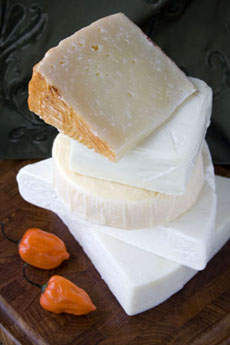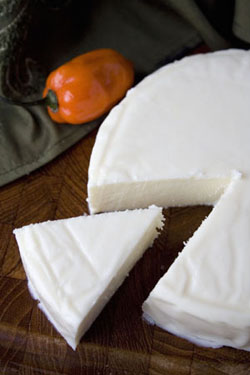

From top: Roth Käse GranQueso, Queso Blanco and Queso Quesadilla from El Viajero, Roth Käse Cotija and El Viajero Cotija. Photography by Claire Freierman | THE NIBBLE.
|
STEPHANIE ZONIS, Contributing Editor, focuses on good foods and the people who produce them.
|
|
March 2008
|
 |
Hispanic Cheese
Hispanic & Other Latino Cheeses Are Heating Up American Kitchens
Page 1: Overview
- Click here to read other months’ Whey To Go columns
This is Page 1 of a five-page article. Click on the black links below to visit other pages.
Overview
Hispanic cuisine is in! Walk down a street, turn on the television, surf the web, and you’ll see or hear about a new restaurant or recipe that promises “authentic” Hispanic/Central American/Caribbean cuisine. Just as there are cheeses that are an integral part of the cuisines of France, Italy and the U.K., there are distinctive Hispanic cheeses that perfectly suit both authentic dishes and those that evolved in U.S. (in Texas and California, for example). Given the growth of the Latino population in the U.S. and the further penetration of Latino foods into the mainstream U.S. diet, the general Hispanic cuisine has been brought more into the spotlight via restaurants, media and recipes. And so have these great cheeses.
Some dishes in Latin American cuisine can be spicy-hot, but don’t think that Hispanic cheeses will be laden with jalapeños or chipotles, spiked with black pepper or cayenne and/or heavily flavored with other agents that pack a wallop. (If you noted the habañero chiles in our photographs, they’re purely for “regional color”—literally and figuratively.) Certainly, aged Hispanic cheeses tend to be strongly flavored, as are most aged cheeses, but the most traditional cheeses are milder in flavor. You will sometimes find them spiced, especially in the U.S., but don’t make the mistake of lumping all of them into one flavor class.
While more Hispanic-style cheeses are produced in California than anywhere else in the U.S.—not surprising given the size of the cheese-making industry and the local demands of the state’s Latino population, Wisconsin, our other cheese making titan, is responsible for an increasing share of the growing Hispanic cheese market. And, of course, these cheeses are produced in many other states, just in smaller quantities. America’s greatest Hispanic-style artisan cheese maker may well be Paula Lambert of The Mozzarella Company in Dallas.
The biggest challenge in getting to know these cheeses is that it isn’t unusual for them to be called by more than one name. Yes, this certainly can create confusion. For example, Queso Blanco may also be called Queso Blanco Fresco, resulting in possible confusion with another cheese called simply Queso Fresco. Marilyn Wilkinson of the Wisconsin Milk Marketing Board realizes that similar names may result in some bewildered consumers, but she believes this issue isn’t a critical one. She says that some cheese names, especially names for fresh cheeses, are regional, but the cheeses themselves can be similar, likening the differences to those between a Parmesan and a Grana Padano. (See our article on Italian Grating Cheeses for the differences between Parmigiano-Reggiano and Grana Padano.)
There are three basic categories of Hispanic cheeses: fresh, melting and hard or aged. Let’s get to know the cheeses and their regional alter-egos.
Fresh Hispanic Cheeses
Like fresh American and European cheeses, Hispanic fresh cheeses are mild in flavor, usually white or off-white in color. Some have a slight saltiness. Textures range from  moist and firm (think of fresh mozzarella) to moist and crumbly (think feta) to moist and slightly grainy (like ricotta). When the making of these cheeses was being done only on a smaller scale, most had a shelf-life of less than seven days. They would be delivered to market wrapped in banana leaves; any cheese unsold after five days was sent back to the cheese maker. With modern, larger-scale production, the cheeses are still quite perishable and must be kept refrigerated, but most now have a longer shelf-life—especially because they are made from pasteurized milk in modern facilities with reliable refrigeration systems. moist and firm (think of fresh mozzarella) to moist and crumbly (think feta) to moist and slightly grainy (like ricotta). When the making of these cheeses was being done only on a smaller scale, most had a shelf-life of less than seven days. They would be delivered to market wrapped in banana leaves; any cheese unsold after five days was sent back to the cheese maker. With modern, larger-scale production, the cheeses are still quite perishable and must be kept refrigerated, but most now have a longer shelf-life—especially because they are made from pasteurized milk in modern facilities with reliable refrigeration systems.
Photo: Queso Fresco from Wisconsin’s El Viajero.
Perhaps the biggest difference between fresh Hispanic-style cheeses and fresh American-style cheeses is that the Hispanic cheeses do not melt when they’re exposed to heat. They’ll become warm and softer in texture, but they don’t lose their shape. If you’re familiar with Halloumi (native to Cyprus, with the texture of mozzarella with the briny moisture of feta), this is exactly the same principle. It’s fun to fry up squares of any of the fresh Hispanic cheeses on the griddle and watch them soften but not run. These fried cheese squares make a great snack all by themselves. You can enjoy them savory, plain or coated in bread crumbs (try Japanese panko crumbs); or you can dust them with powdered sugar and cinnamon for a sweet snack or a dessert.

Queso blanco holds its shape when cooking.
Slice and fry (breading optional). Cheese from
El Viajero. |
Commonly-available fresh Hispanic cheeses include:
- Panela (pah-NAY-lah), similar in taste and texture to fresh mozzarella, it’s commonly added to salads or sandwiches or served with fruit.
- The immensely popular Queso Blanco (KAY-so BLAHN-koh, a.k.a. Queso Blanco Fresco) has a fresh, crumbly curdy texture, and is often fried. A cooking and snacking cheese, it softens, but holds its shape, when sliced and heated. It is shredded over casseroles, potatoes and enchiladas and crumbled onto tropical fruit salad, beans and green salads. As a snack, it is enjoyed cold with crackers or fruit. Some companies make it with bits of tropical fruit added.
- Queso Fresco (KAY-so FRES-KOH), is a soft, moist, fine-grained cheese, crumbles readily, and is frequently used as a topping or filling in cooked dishes like enchiladas, refried beans, salads, soups, tostadas and taco salads. It has traditionally been made at home, as Italians make mozzarella.
|
- Queso Para Freir (KAY-so PAH-rah FRY-eer), a close relative of Queso Blanco, is saltier. With the name “para freir” (“for frying”), it’s easy to figure out how most people use this cheese, which can be cubed and deep-fried as appetizer nuggets or sliced and fried to a golden brown on a griddle.
- Requeson (reh-KAY-sown), the Hispanic equivalent of ricotta, is made from whey (as is ricotta). Like its Italian cousin, its fresh, milky flavor works best in desserts, fillings in cooked foods and in spreads.
While it isn’t a cheese, also noteworthy is Mexican cultured sour cream. All sour cream is cultured; it is made by fermenting heavy cream with a bacterial culture that mildly sours the cream through the production of lactic acid, and thickens it.
- Crema Mexicana (CRAY-mah may-hee-CAH-na), often called simply crema or fresh cream (which can be confusing, because it’s not what we think of as fresh cream), is richer and more complex in flavor than American sour cream. It’s more akin to British clotted cream. Sour cream lovers will want to give it a try. You’ve seen crema on Mexican entree dishes, but it is also enjoyed with breakfast cereal, in dips and with berries. Read our review of Chipilio, a particularly outstanding brand that happens to be made in Wisconsin (since fresh dairy products currently cannot be imported). Nationwide distribution of crema is still limited at this time, but you can find recipes online. It’s easy to make at home.
Continue to Page 2: Hispanic Melting Cheeses
Go To The Article Index Above
Lifestyle Direct, Inc. All rights reserved. Images are the copyright of their respective owners.

|





 moist and firm (think of fresh mozzarella) to moist and crumbly (think feta) to moist and slightly grainy (like ricotta). When the making of these cheeses was being done only on a smaller scale, most had a shelf-life of less than seven days. They would be delivered to market wrapped in banana leaves; any cheese unsold after five days was sent back to the cheese maker. With modern, larger-scale production, the cheeses are still quite perishable and must be kept refrigerated, but most now have a longer shelf-life—especially because they are made from pasteurized milk in modern facilities with reliable refrigeration systems.
moist and firm (think of fresh mozzarella) to moist and crumbly (think feta) to moist and slightly grainy (like ricotta). When the making of these cheeses was being done only on a smaller scale, most had a shelf-life of less than seven days. They would be delivered to market wrapped in banana leaves; any cheese unsold after five days was sent back to the cheese maker. With modern, larger-scale production, the cheeses are still quite perishable and must be kept refrigerated, but most now have a longer shelf-life—especially because they are made from pasteurized milk in modern facilities with reliable refrigeration systems.